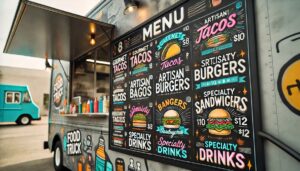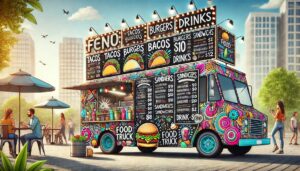Figuring out the menu prices for a concession business or food truck isn’t as simple as guessing what looks right. Every price in any food establishment is based on a variety of factors that the owner must consider before landing on a price that will satisfy customer and your business. Keeping these profits up through menu pricing is another important duty of any food truck owner or you might end up losing money.
The Math Behind Menu Pricing
At the end of the day, pricing is mostly determined by numbers and finding that sweet spot that helps you break even and turn a profit over time.

Burger Truck Menu Board.
Step 1: Calculate Your Expenses
Start by listing every major and minor expense in a spreadsheet. This includes:
- Food costs
- Employee wages
- Rent/Permits
- Electricity and Gas
- Miscellaneous expenses like repairs
After adding all these costs, focus on your food costs. Ideally, your food costs should be around 33% of your total expenses. If it’s significantly less, you might have other high costs to examine. If it’s more, you’ll need to reduce it to avoid future problems.
Step 2: Determine Per Serving Cost
Next, calculate the per serving cost of each menu item based on food costs. A simple approach is to ensure that 33% of your overall costs should be about 23% of your final menu price. Multiply your food cost by 4 to get the menu price that covers all costs and provides a profit.
Example: Pricing Menu Items for a Burger Truck
Let’s walk through a detailed example to help you understand how to price items for a burger truck.
Classic Cheeseburger
- Ingredient Costs:
- Bun: $0.50
- Patty: $1.00
- Cheese: $0.30
- Lettuce, Tomato, Onion: $0.20
- Condiments: $0.10
- Total Food Cost: $2.10
- Calculate Menu Price:
- Food Cost: $2.10
- Target Food Cost Percentage: 23%
- Menu Price = Food Cost / Target Food Cost Percentage
- Menu Price = $2.10 / 0.23 ≈ $9.13
- Rounding:
- Rounded Menu Price: $9.00
Bacon Avocado Burger
- Ingredient Costs:
- Bun: $0.50
- Patty: $1.00
- Cheese: $0.30
- Bacon: $0.75
- Avocado: $0.70
- Lettuce, Tomato, Onion: $0.20
- Condiments: $0.10
- Total Food Cost: $3.55
- Calculate Menu Price:
- Food Cost: $3.55
- Target Food Cost Percentage: 23%
- Menu Price = Food Cost / Target Food Cost Percentage
- Menu Price = $3.55 / 0.23 ≈ $15.43
- Rounding:
- Rounded Menu Price: $15.50
Veggie Burger
- Ingredient Costs:
- Bun: $0.50
- Veggie Patty: $1.20
- Cheese: $0.30
- Lettuce, Tomato, Onion: $0.20
- Condiments: $0.10
- Total Food Cost: $2.30
- Calculate Menu Price:
- Food Cost: $2.30
- Target Food Cost Percentage: 23%
- Menu Price = Food Cost / Target Food Cost Percentage
- Menu Price = $2.30 / 0.23 ≈ $10.00
- Rounding:
- Rounded Menu Price: $10.00
While calculating your major expenses is crucial, it’s equally important not to overlook the smaller costs associated with running your food business. Items such as condiments, seasonings, straws, and packaging may seem minor individually, but together, they can add up to a significant portion of your overall expenses.
Ignoring these small yet essential expenses can lead to budget discrepancies and affect your profitability. By carefully tracking and managing these costs, you ensure a more accurate understanding of your financial picture and help maintain healthy profit margins. Always include these expenses in your financial planning to avoid surprises and ensure your business remains profitable and sustainable.
Simplifying and Adjusting Prices
Once you have determined the mathematical figures for your costs and pricing, you may end up with non-round numbers, such as $7.43. Instead of using this exact amount, it’s advisable to round up to a whole number like $8. This approach serves several purposes:
- Simplicity: Rounded numbers are easier for customers to process and remember.
- Covering Unexpected Costs: The small extra amount can help cover any unforeseen expenses that may arise.
- Increased Profit Margin: The slight increase can provide a buffer, potentially increasing your profit margins without significantly impacting customer perception.
By rounding up, you not only create a cleaner, more attractive price point, but you also build in a small cushion to help manage the financial unpredictability that comes with running a food business. This strategy is particularly important in an inflationary environment, where costs can rise unexpectedly and frequently.

Determine your food truck menu prices.
Check Competitor Prices
Always compare your menu prices with other local food trucks. If similar items are priced higher on your menu, you might need to lower your prices to attract more customers. Alternatively, consider adding lower-priced items to your menu to appeal to a broader audience. Ensure that higher prices are justified by high-quality products.
Some industries, like snow cones, have high profit margins and can command higher prices compared to their costs. For example, the cost of ingredients for a snow cone is minimal (ice, flavored syrup, and a cup), but they can be sold at a high markup. If you see other trucks successfully selling high-margin items at premium prices, it suggests a potential opportunity for your menu.
I always suggest driving around your town and visiting restaurants or food trucks with similar menus. If you’re planning to open a taco truck, take a look at how the business prices there menu. If you’re opening a coffee cart, visit similar businesses around the area and find out how much they charge for drip coffee, espressos, or hot chocolates so you have a ballpark idea on what you can charge.
At the same time you’re getting an estimate of menu prices, you can also use this opportunity to get ideas for your menu. What are these trucks offering as appetizers? Do they offer any upgrades or upsells when you make a purchase? You can learn a lot about how to be profitable on a food truck by paying close attention to other entrepreneurs already in the business.
Cost Reduction Strategies
You don’t always need to increase prices to increase profit. Reducing costs or food waste is equally important. Here are some tips:
- Efficient Operations: Ensure food prep is efficient, employees don’t work unnecessary hours, and equipment is well-maintained.
- Bulk Buying: Purchase long-lasting dry and frozen foods in bulk. Buying from a big-box retailer like Costco can also help. If you join at the Executive Business level, Costco will give you 2% cash back on all purchases. Programs like this can put a lot of money back in your pocket at the end of the year.
- Handmade Items: Make items by hand when possible, as it’s often cheaper and can lead to better quality.
- Simplified Serving: Serve food in ways that reduce costs, such as eliminating side dishes or using hand-held options.
- Used Equipment: Consider buying used equipment that’s in good condition to save money.
Remember, each city has different regulations and permits, so tailor your approach to local requirements. By following these steps and strategies, you can set profitable and competitive prices for your food truck menu.
I always suggest evaluating menu prices at least one time per year on a food truck. After all, we’ve seen the price of food items become highly volatile over the past few years. For example, wing prices have more than doubled in the last 12 months according to the WSJ. You will need to pay attention to make sure you’re selling items at a profit and ensuring your food truck is financially healthy for the longterm.
Helpful Links
How the Best Food Trucks Deal with Food Costs – Just what it says.
Menu Pricing Methods – the ‘For Dummies’ look into the two main calculation strategies for pricing based on costs

Leave A Comment